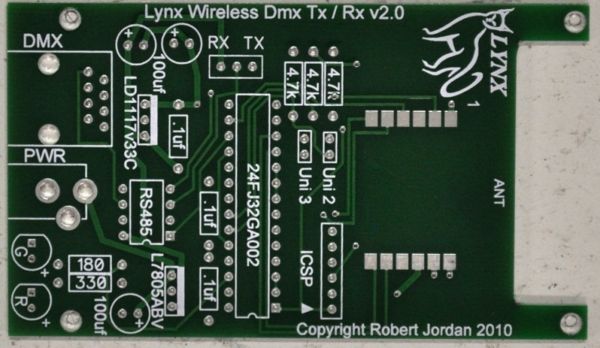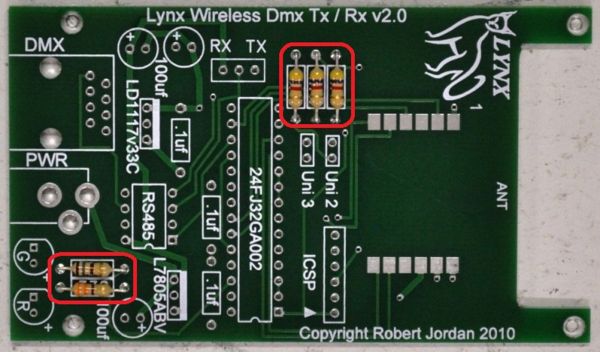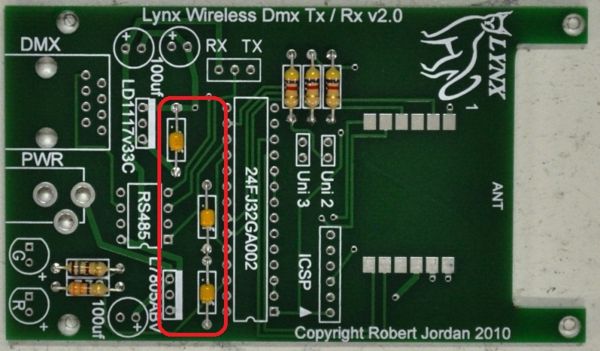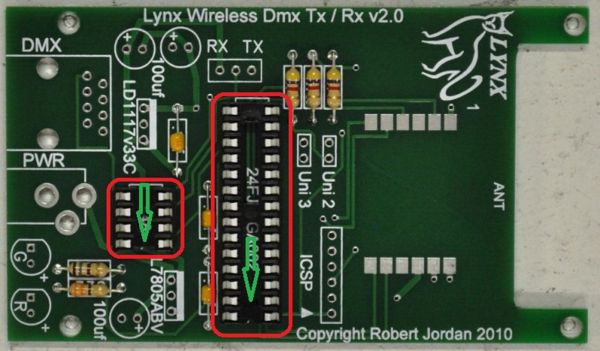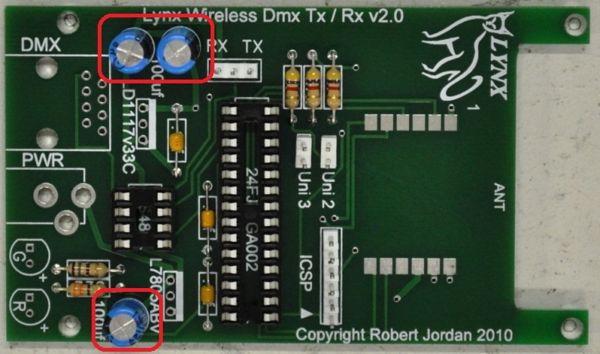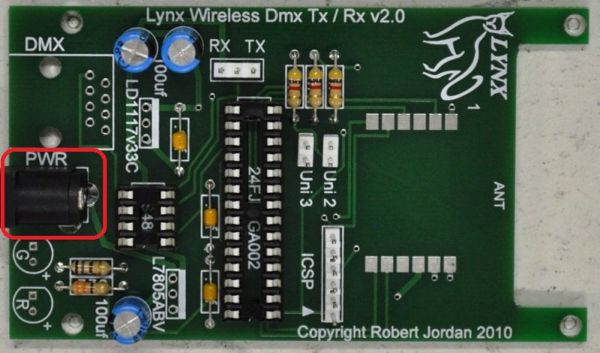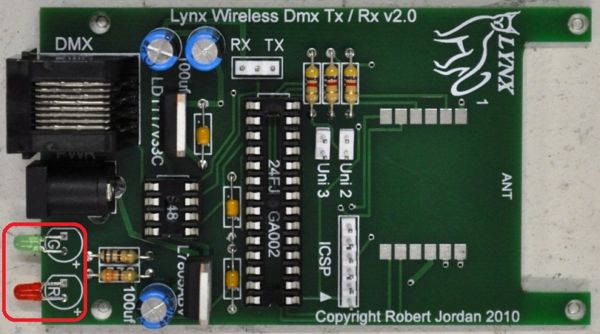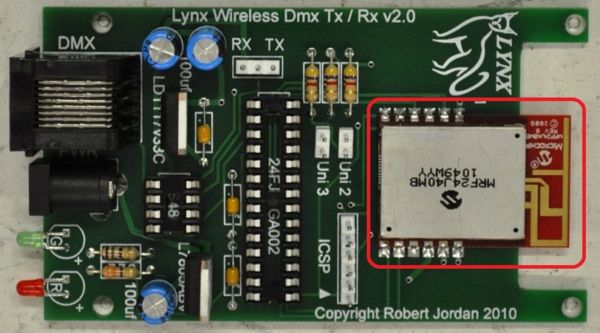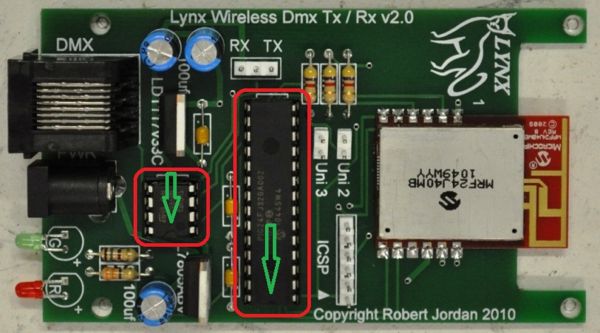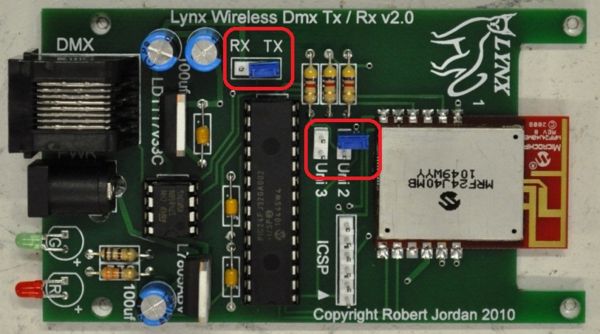Manual TX RX2

Notice
If you ordered your Wireless TX/RX v2.0 through a COOP your PIC will come programmed by the COOP manager.
If you did not order your kit through a COOP the PIC does NOT come pre-programmed from Microchip or any supplier. If you do not have a programmer then please see the PIC Programming Wiki page for a list of DLA users who can program the PIC for you. If you are programming the PIC yourself, download the hex firmware file from the Wiki and program the PIC chip using the appropriate steps for your programmer setup. Check out this post for a helpful pdf on PIC programming. Some helpful tips on PIC programming can also be found on this You Tube video.
If you do not have a case with pre-cut holes, you will need to cut one square hole for the Cat 5 connector, drill a hole for the power connector and drill two holes for the LED's. Use a 9/64 inch drill bit to make the holes for the LED's.
Introduction
Thank you for making the decision to build the Lynx DMX Wireless TX/RX. I believe this decision will be one you will be very happy with. The Lynx is my attempt to design the best DMX wireless transmitter/receiver I could, at the lowest price I could, and make it available for the do-it-yourselfers like you. The goals for the device were professional looks and operation, cost effectiveness and ease of assembly for even a novice builder.
WARNING! This device has been designed for personal use as a means of education and entertainment. As such it is not rated, tested, or approved for use in commercial environments and such use is forbidden by the designer. Improper use of this equipment could be hazardous to life and property and the suitability of use is your responsibility. I assume no responsibility in the use or operation of this equipment or for the accuracy of any information made on part of itself. This device has been designed for my use and my use only. This is simply an explanation of how I built my own personal dimmers for informational purposes. I make no warranties written or otherwise to it. It should be considered an experimental device with possible unknown characteristics.
Before we start assembly of the Lynx DMX Wireless TX/RX, use the Mouser Direct link on the Equipment Wiki page to verify you have the correct parts and quantity of parts before we go any further. Please use static electricity precautions in the handling of these parts (ground straps, etc.). If you are not familiar with them please research on the Internet prior to handling them. You can damage your parts with improper handling!
Ensure you are using the correct Lynx DMX Wireless TX/RX PCB for this assembly manual.
Preparing to Build
The next thing we want is to make sure you are up to speed on soldering and electrostatic protection of the components in your kit. If you are not an experienced printed circuit builder, visit the Curious Inventor website and review the How to Solder guides just below the video. The video on soldering correctly at the top of the page is extremely good to watch even if you are experienced at soldering.
Another issue you must be aware of is that some electronic components can be damaged easily by electrostatic charges that can build up in you or your equipment. We have all been shocked by walking on carpet and grabbing a doorknob. This is electrostatic charge in action. It takes much less than this to hurt some of the parts. If you are unfamiliar with procedures to protect from this, please use the Internet to research it before opening your parts up. You can damage your parts with improper handling!
You will need a few tools build the Lynx DMX Wireless TX/RX. You will need a good soldering iron. I cannot stress enough that a good soldering iron makes a big difference in these projects. The little 15w cheap irons are more apt to hurt your parts by taking too long to get the parts up to soldering temperature than a good iron which can bring it up to temp very fast. Remember, damage is a factor more in how long you keep the part hot than it is how hot you get it (within reasonable soldering temperatures). A good soldering iron is reasonable: You can purchase one for $30 to $60. Most any product that calls itself a soldering station that includes a temperature control separate from the iron itself will more than likely be fine, but make sure it is rated for more than 15 watts. I use a cheap Weller like this: Weller Soldering Station. It works fine and is very inexpensive. I even saw this model on sale at Sears. Radio Shack has a very nice looking digital model on sale but be careful: it does not allow you to replace the tip. Tips are a part that wear out and need to replace them from time to time. While we are on the topic of tips, get some. I recommend you get the smaller chisel shape as this works very well for all-around board building.
You need solder, so buy some. I recommend .032 size as the larger sizes tend to cause you to put too much solder on. How much? Go ahead and get a 1 lb spool as it’s cheaper in large volume and you will go through it faster than you think. Make sure you are getting rosin core for electronics; they make some solder for plumbing that has acid as the core and this is a bad mistake to make.
You need some work area to work with good lighting. Do not attempt to solder circuit boards in poorly lighted areas. If you wear reading glasses, go get them: you will want them I promise you. I also recommend getting a helping hands tool similar to this: Helping Hands Tool.
PCB Assembly
Since this wireless device is meant to expand the capability of other Lynx equipment you probably have a few successful Lynx builds accomplished. The components are separated into groups for soldering in a step by step procedure for you to follow. Starting with a bare Lynx DMX Wireless TX/RX PCB, components are outlined in red as they are soldered to the board. Ensure that you orient the parts as shown on the PCB and in the assembly pictures.
I know you are excited at this point but don't rush and have fun!!!
- Install three 4.7k ohm resistors (yellow, violet, red)
- Install one 330 ohm resistor (orange, orange, brown)
- Install one 180 ohm resistor (brown, gray, brown)
- Install three 0.1uf ceramic capacitors (small yellow ball)
- Install one 8 pin socket aligning so the notch on the socket matches the notch on the board
- Install one 28 pin socket aligning so the notch on the socket matches the notch on the board
- Install two 2 pin headers
- Install one 3 pin header
- Install one 6 pin headers
- Install three 100uf electrolytic capacitors observing polarity (long lead is positive)
- Install one power connector
- Install one 5.0V voltage regulator
- Install one 3.3V voltage regulator
- Install one RJ45 jack ensuring that it is flat against the board
- Install one red LED observing polarity (long lead is positive) by making a 90 degree bend 5/32 inch (4 mm) from the base of the LED
- Install one green LED observing polarity (long lead is positive) by making a 90 degree bend 5/32 inch (4 mm) from the base of the LED
- Note: Once installed the base of the LED's should be flush with the edge of the board
- Install the RF module by aligning the pads and holding slight downward pressure while soldering
- Note: You will probably need a hand (or helping hands) to hold the RF module in place while you solder it, some members have used blue painters tape or a small amount of white glue to hold the module in place
- Install one RS485 chip in the 8 pin socket aligning the notch on the chip with the notch on the socket being careful not to damage the pins
- Install the programmed PIC in the 28 pin socket aligning the notch on the chip with the notch on the socket being careful not to damage the pins
- Install one jumper selecting the transmit (TX) or receive (RX) mode of operation
- Install one jumper selecting the desired Wireless universe
- No Jumpers = Universe 1
- Jumper on "Uni 2" = Universe 2
- Jumper on "Uni 3" = Universe 3
- Note: If using the first Wireless universe the second jumper is not used and can be stored on the board as shown
- Using four screws mount the PCB in the case aligning the LED’s with the holes in the case
- Using four screws attach the top cover on the case
Congratulations!!! You now have a Lynx DMX WirelessTX/RX module
Thank you, enjoy your Lynx DMX Wireless capability.
